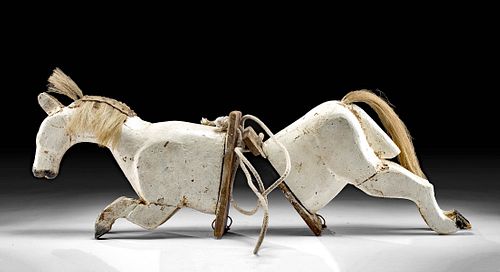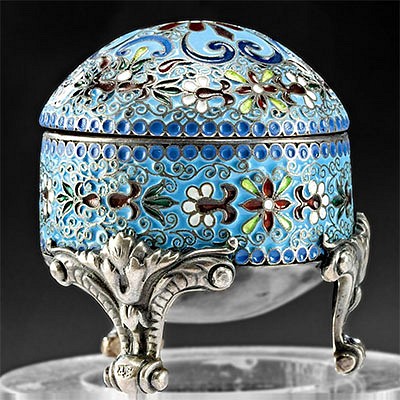19th C. Mexican Painted Wood Horse - Caballo Santiago
Lot 25
About Seller
Artemis Gallery
686 S Taylor Ave, Ste 106
Louisville, CO 80027
United States
Selling antiquities, ancient and ethnographic art online since 1993, Artemis Gallery specializes in Classical Antiquities (Egyptian, Greek, Roman, Near Eastern), Asian, Pre-Columbian, African / Tribal / Oceanographic art. Our extensive inventory includes pottery, stone, metal, wood, glass and textil...Read more
Categories
Estimate:
$800 - $1,200
Absentee vs Live bid
Two ways to bid:
- Leave a max absentee bid and the platform will bid on your behalf up to your maximum bid during the live auction.
- Bid live during the auction and your bids will be submitted real-time to the auctioneer.
Bid Increments
| Price | Bid Increment |
|---|---|
| $0 | $25 |
| $300 | $50 |
| $1,000 | $100 |
| $2,000 | $250 |
| $5,000 | $500 |
| $10,000 | $1,000 |
| $20,000 | $2,500 |
| $50,000 | $5,000 |
| $100,000 | $10,000 |
| $200,000 | $20,000 |
About Auction
By Artemis Gallery
Apr 1, 2021
Set Reminder
2021-04-01 12:00:00
2021-04-01 12:00:00
America/New_York
Bidsquare
Bidsquare : Odd Unusual Finds | Antiquity to Present Day
https://www.bidsquare.com/auctions/artemis-gallery/odd-unusual-finds-antiquity-to-present-day-6742
Ancient, Asian, Pre-Columbian, Ethnographic, American, and everything in-between Wild, weird, strange, interesting - who knows what you'll find. All pieces guaranteed to be as described. Convenient in-house shipping. Artemis Gallery info@artemisgallery.com
Ancient, Asian, Pre-Columbian, Ethnographic, American, and everything in-between Wild, weird, strange, interesting - who knows what you'll find. All pieces guaranteed to be as described. Convenient in-house shipping. Artemis Gallery info@artemisgallery.com
- Lot Description
Latin America, Mexico, Guerrero, El Texcal/Almoloya, ca. late 19th to early 20th century CE. An interesting wooden festival horse worn during the traditional Santiago Dance in Puebla known as a "Caballo Santiago." The horse is comprised of two sections, the front and rear end, held together with lengths of rope in the center. The ropes also attach the horse to a dancer's waist. The horse is simply made, with a painted white surface and black pigments highlighting the nose and hoofs. White tufts of actual horsehair are attached as the mane and tail. The horse is worn around the waist by a dancer known as a Santiaguero, a follower of Saint James (Santiago). The Santiago dance portrays an encounter between Santiago Caballero, a reincarnation of Saint James the Apostle who appears as an archangel mounted atop a white stallion, and a group of dancers representing Satan and his followers, known as the Pilatos (after Pontius Pilate). The dance also features the subtext that the Santiagueros, who are mostly the Indians of the Sierra de Puebla, represent the true followers of Christ while the Pilatos represent the Spanish conquistadors who claimed to be Christians but treated the Indians poorly. The horse itself is treated with great respect; with and the dancer's sole role is to protect the horse! A wonderful cultural piece! Size: 21" L x 3.25" W x 11.5" H (53.3 cm x 8.3 cm x 29.2 cm)
Provenance: private Tucson, Arizona, USA collection, acquired between 1950 and 1985
All items legal to buy/sell under U.S. Statute covering cultural patrimony Code 2600, CHAPTER 14, and are guaranteed to be as described or your money back.
A Certificate of Authenticity will accompany all winning bids.
We ship worldwide and handle all shipping in-house for your convenience.
#148649Stable fissures and cracks. Chips to nose and hoofs. Chipping of pigments. Minor losses and shedding to mane and tail hair. Rope is adjustable.Condition
- Shipping Info
-
All shipping is handled in-house for your convenience. Your invoice from Artemis Gallery will include shipping calculation instructions. If in doubt, please inquire BEFORE bidding for estimated shipping costs for individual items.
-
- Buyer's Premium



 EUR
EUR CAD
CAD AUD
AUD GBP
GBP MXN
MXN HKD
HKD CNY
CNY MYR
MYR SEK
SEK SGD
SGD CHF
CHF THB
THB













